The old Arab paper mill
or Grangia of the Ricchisgia 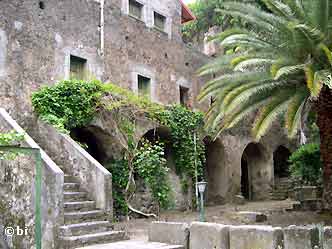 The "Ricchisgia" (from Greek Rhiacos or Rhiax = river of lava, place wasted by lava) is a fertile and water rich place. The "Ricchisgia" (from Greek Rhiacos or Rhiax = river of lava, place wasted by lava) is a fertile and water rich place.
Here a small paper mill built (probably by Arabs in the first years of the XI century): stood below a lava ravine overhanging on the Simeto banks, close to a spring called of Malpertuso, near today's bridge Passo Paglia. The Ricchisgia, subsequently, was changed in a "Grangia" or "Grancia" (from the ancient French "granche", granary), that is an agricultural community built alongside a little convent where the Benedictine friars (and then the Basilians) also farmers, were praying and living of agriculture and of other small industries linked to it. Such Grangia was depending on the Benedictine abbey of Holy Maria Of Maniace, to which was, somewhat, subjected and from where, every year, "jus padronato", the abbots were coming to pass the winter. The pleasant place did not give hospitality to the abbots of Maniace after the awful earthquake that took place on Sunday January 11th, 1693 at 21 (then, four hours at night).
In that sad day the Maniace Abbey was razed completely to the ground together with the chorus; remained only the ruins of the three naves. In that terrible earthquake many Sicily country towns disappeared and in Catania of 25.000 inhabitants nearly 17.000 died, so that remained the saying: "guardati Catania a vintun’ura" (look out Catania at twentyone hours). | The Basilians moved to the near Bronte, in San Blandano district, after going through long fights against the local clergy that did not want them in the urban center, but wanted to relegate them to a district called Sciarone, a deserted area of lava, about 10 kilometers from the center. The pleasant little church of the Grangia of the Ricchisgia dedicated to S. Benedetto, was officiated, in the Benedictine time, (1174-1585), by the Basiliani in (1585 -1586), by the hermits of Sant'Agostino, by the monks of S. Francesco (1586 -1593) and at last by the Basilians who got back (1593-1870) not as masters any longer, like in the last centuries, but only to celebrate the holy rites on Sunday and on other particular celebrations. In the Grangia of the Ricchisgia there was a water mill, the straw paper factory and a structure called "paratore" to make wool drape (rough irregular fabric similar to orbace,(famous material used for fasciost uniforms) whose final touches were made by hand using looms then existing in Bronte. The drapes were sold also in Palermo, transported with handcarts or mules caravans, going across the Royal trail that through the Cattaino feud and the woods would get to the beaches of the capital. From here comes the legend of the barter for the statue of our patron saint, the Annunziata, against the drapes.
| The church, then, was detached by the principal body of the convent, that, in the ground floor had the kitchen and the refectory, the cellars, the granaries and other stores.
Later on, between the church and the convent, another three rooms were built and an outside wood stair to connect the ample balcony shaped as a corridor (where to dry the paper) supported by three big arcades. Can be justly said that the humble, laborious, friars constituted the first agricultural and industrial core of Bronte: They were grinding the grain, making rough cloths and paper, they were tilling the soil, helping the local villagers by supplying them also with a sulphurous water (not existing anymore) dripping from the lava bounds overhanging the convent. Adjacent to their convent, in the Marotta estate cultivated all to pomegranates, the Pisciagrò Barons of Randazzo built also a mill (whose ruins still exist) where, with the precious cooperation of the farming friars, the fruits juice was extracted and a liqueur-like dessert wine was made and also exported. |
|
A bit of history
The Grangia of the Ricchisgia was depending from the Benedictine Abbey of Holy Maria of Maniace, and it had to follow, through the centuries, all its unjust and tormented destinies: In 1494, Pope Innocent VIII gave it, free title, in endowment, to build a poor mans' "Grand and New Hospital" in Palermo. Three centuries later, in 1799, the Abbey underwent a second illicit transfer, (this time disguised as a regal donation) by the Bourbon sovereign of the moment, king Ferdinand of the two Sicilies, in favor of Horatio Nelson as reward for having drowned in blood the "Neapolitan Republic" rising. |
|
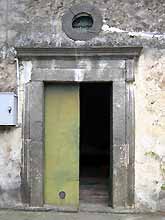 | 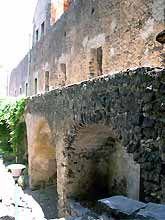 | Few current state images of the Ricchisgia Grangia Basiliana: Above a view of the entry prospect with, to left, the simple prospect of the little church, in ancient times, dedicated to San Benedetto. In the two other images can be noticed the row of windows lighting up the humble little cells of the laborious friars. | 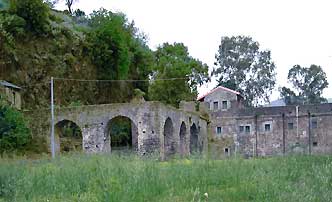 | 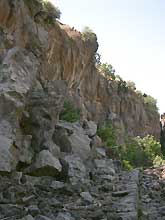 | 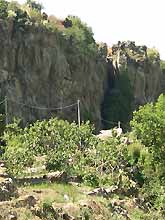 | The Paper mill of the Ricchisgia stood on a fertile and water rich place, below a lava ravine overhanging the Simeto banks, near a spring said of Malpertuso, near today's bridge Passo Paglia. The water for the mill and other facilities for producing paper and wool | 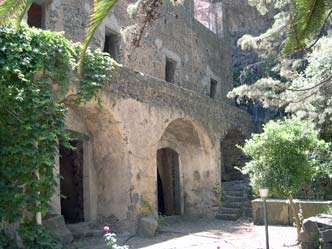 | drape was transported through an old aqueduct still in existence. |
|
|